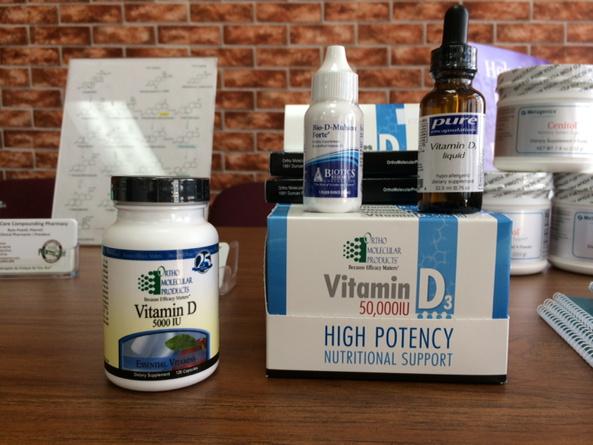Vitamin D deficiency can cause serious health issues. Everyday it seems that another study comes out that links vitamin d deficiency to a new disease state. Have you ever had your vitamin d level checked? Are you at risk for a deficiency?
Vitamin D3 is a lipid soluble pro-hormone stored in the skin. Ultraviolet B radiation from the sun converts the precursor 7-dehydrocholeserol in our skin to cholecalciferol (vitamin D3), where it is transported to the liver and undergoes hydroxylation to 25-hydroxyvitamin D (25-OH-D3.) This is the major circulating metabolite of vitamin D. The final step of hydroxylation occurs in the kidney to produce the active hormone, 1, 25-dihydroxyvitamin D (1, 25-OH2D or calcitriol). In turn, calcitriol will act on the intestine, bone, and kidney for the maintenance of calcium and phosphorus. The active hormone is stored in the liver, fat and muscle.
Special Points of Interest
- One billion people worldwide have a vitamin D deficiency or insufficiency.
- In elderly women, when given 1200mg of calcium and 800 IU of vitamin D3 daily for 3 years, hip fractures were reduced by 43%!
- Those with adequate vitamin D have a 50% reduced risk of developing breast or colorectal cancer.

Vitamin D Deficiency
In patients with vitamin D deficiency, only 10-15% of dietary calcium and 60% of phosphorus is absorbed. Deficiency of vitamin D is defined as 25-OH-D levels of less than 20 ng/mL. It has been shown that consistent levels of less than 50ng/mL may lead to other problems or disease states.
Osteomalacia and rickets are the two most common issues seen with deficiency. Hyperparathyroidism results from low serum vitamin D and calcium, which causes the release of PTH; a continuation of this process leads to osteomalacia. Other effects include an increase in the incidence of osteoporosis and receptors are also found on T helper cells which helps to suppress autoimmune diseases such as diabetes and irritable bowel syndrome. Heart tissue contains vitamin D receptors as well, which can lead to cardiovascular disease with deficiency. It affects contractility, vascular tone, collagen content, and tissue maturation. Adequate vitamin D serum levels have shown a decrease in incidence of brain, colon, breast and prostate cancers by apoptosis induction and prevention of angiogenesis.
High Risk Vitamin D Deficiency Patients
Patients at high rish for vitamin D deficiency include: breast fed infants; older adults due to a decrease in the ability to synthesize vitamin D in the skin; limited sun exposure; dark skin due to a lesser ability to produce vitamin D through the skin; fat malabsorption; and obese individuals because fat sequesters more vitamin.
Why Supplement with Vitamin D3?
It is imperative to note that the form of vitamin D supplementation should be cholecalciferol (D3), which is the most active form. Vitamin D2 is only 30% active compared to D3. Current vitamin D3 recommendations for children is 400 IU – 1000 IU/day; adults 1000 IU – 2000 IU. Due to the risk of osteoporosis following menopause women are encouraged to maintain higher serum levels. An adequate amount of vitamin D3 may be obtained through 5 to 30 minutes of sun exposure twice a week to arms and legs between 10 a.m. and 3 p.m. The majority of tanning beds can be recommended as a source of vitamin D3 in moderation due to their ability to emit 2% to 6% of ultraviolet B radiation.
Long Term Health
As more research is conducted, we are finding that adequate vitamin D levels are imperative for our long term health. For more information or a recommendation on a vitamin D3 product contact PharmaCare Compounding Pharmacy at (330)-633-0714.
Referenes
- Wike-Malone R, Kessenich C. Vitamin D deficiency: implications across the lifespan. J Nurse Practitioners 2008;4(6): 448-454.
- Holick MF. Vitamin D deficiency. N Engl J Med 2007; 357: 266-281.